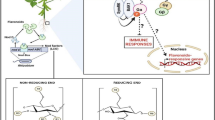Abstract.
Nod factors are lipo-chito-oligosaccharides secreted by rhizobia that initiate many responses in the root hairs of the legume hosts, culminating in deformed hairs. The heterotrimeric G-protein agonists mastoparan, Mas7, melittin, compound 48/80 and cholera toxin provoke root hair deformation, whereas the heterotrimeric G-protein antagonist pertussis toxin inhibits mastoparan and Nod factor NodNGR[S]- (from Rhizobium sp. NGR234) induced root hair deformation. Another heterotrimeric G-protein antagonist, isotetrandrine, only inhibited root hair deformation provoked by mastoparan and melittin. These results support the notion that G-proteins are implicated in Nod factor signalling. To study the role of G-proteins at a biochemical level, we examined the GTP-binding profiles of root microsomal membrane fractions isolated from the nodulation competent zone of Vigna unguiculata (L.) Walp. GTP competitively bound to the microsomal membrane fractions labelled with [35S]GTPγS, yielding a two-site displacement curve with displacement constants (K i) of 0.58 µM and 0.16 mM. Competition with either ATP or GDP revealed a one-site displacement curve with K i of 4.4 and 29 µM, respectively, whereas ADP and UTP were ineffective competitors. The GTP-binding profiles of microsomal membrane fractions isolated from roots pretreated with either NodNGR[S] or the four-sugar, N-N'-N"-N'"-tetracetylchitotetraose (TACT) backbone of Nod factors were significantly altered compared with control microsomal fractions. To identify candidate proteins, membrane proteins were separated by SDS-PAGE and electrotransferred to nitrocellulose. GTP overlay experiments revealed that membrane fractions isolated from roots pretreated with NodNGR[S] or TACT contained two proteins (28 kDa and 25 kDa) with a higher affinity for GTPγS than control membrane fractions. Western analysis demonstrated that membranes from the pretreated roots contained more of another protein (~55 kDa) recognised by Gαcommon antisera. These results provide pharmacological and biochemical evidence supporting the contention that G-proteins are involved in Nod factor signalling and, importantly, implicate monomeric G-proteins in this process.
Similar content being viewed by others
Author information
Authors and Affiliations
Additional information
Electronic Publication
Rights and permissions
About this article
Cite this article
Kelly, M.N., Irving, H.R. Nod factors activate both heterotrimeric and monomeric G-proteins in Vigna unguiculata (L.) Walp. Planta 216, 674–685 (2003). https://doi.org/10.1007/s00425-002-0900-8
Received:
Accepted:
Issue Date:
DOI: https://doi.org/10.1007/s00425-002-0900-8




